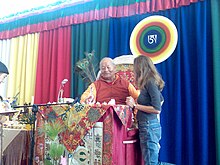Namkhai Norbu
Chögyal Namkhai Norbu Rinpoche ( Tib . : chos rgyal nam mkha'i nor bu rin po che ; born December 8, 1938 in dGe'ug, Dege County , Kham ; † September 27, 2018 in Arcidosso ) was a Tibetan author, historian and Dzogchen master.
At the age of two, Pelyül Karma Yangsid and Shechen Rabjam recognized him as the reincarnation ( Trülku ) of the great Dzogchen master and co-founder of the Rime movement Adzom Drugpa (1842-1924). When Namkhai Norbu Rinpoche was three years old, the 16th Gyalwa Karmapa also recognized him as the spiritual rebirth of Shabdrung Ngawang Namgyel (1594-1651). Shabdrung Ngawang Namgyel, founder and Dharma King (Tib .: Chögyal ; skt . Dharmaraja ) of the state of Bhutan , for his part, is regarded as the incarnation of the Drugpa Kagyu master Pema Karpo (1527–1592).
Life
In his early years, Chögyal Namkhai Norbu Rinpoche studied at the Sakya Dege Gönchen Monastery . Between the ages of eight and twelve he attended the attached monastery school, where he studied Buddhist philosophy with Khyenrab Chökyi Öser for many years . During this time he also received numerous teachings and transmissions from various teaching cycles of Buddhist Tantra and Dzogchen . Been made by many masters, including his paternal uncle Togden Ugyen Tendzin (who later realized the rainbow body), his maternal uncle Khyentse Rinpoche Chokyi Wangchuk and Drubwang Rinpoche Kunga Pelden , Negyab Rinpoche , Drugse Gyurme Dorje , Dzongsar Khyentse Rinpoche and Bo Göngkar Rinpoche .
In 1951 he received special teachings and transmissions from Ayu Khandro Dorje Peldrön, a master who lived and practiced in darkness for over fifty years and was a student of Jamyang Khyentse Wangpo . Chögyal Namkhai Norbu Rinpoche was invited to China in 1953 by the Chinese government to represent the Tibetan youth. After visiting Chengdu and Chongqing , he accepted the invitation to teach Tibetan in Menyag. During this time he met Kangkar Rinpoche, from whom he received teachings on the Six Yogas of Naropa , Mahamudra and Tibetan Medicine , among other things . Back in Tibet, Namkhai Norbu Rinpoche met his root teacher Nyala Rinpoche Rigdzin Changchub Dorje in 1955 and stayed at his home in Khamdogar for almost a year. Changchub Dorje imparted the authentic knowledge of Dzogchen to him, whereupon Namkhai Norbu understood his real essence. This immediate, unconstrained understanding of Rigpa has remained a characteristic of his way of teaching.
In the late 1950s, Chögyal Namkhai Norbu made a pilgrimage to Nepal , India, and Tibet . Due to the difficult political circumstances, he finally broke off his pilgrimage and left Derge. He fled to Gangtok in Sikkim (India), where he lived from 1958 to 1960. There he worked as an author and editor of Tibetan books for the local government.
Because of his in-depth knowledge of all aspects of Tibetan culture , he was invited by Professor Giuseppe Tucci at the age of 22 to work at the Istituto Italiano per il Medio ed Estremo Oriente (IsMEO) in Rome. After four years at the institute, Namkhai Norbu Rinpoche was appointed professor at the Istituto Universitario Orientale in Naples in 1964 , where he taught until 1992. During his stay in Italy, Chögyal Namkhai Norbu focused his research mainly on the ancient history of Tibet, with a special focus on the Bon tradition. His resulting works, which include work on history, medicine, astrology, Bon and folk traditions, are testimony to his deep understanding of Tibetan culture and its origins.
In 1971 Chögyal Namkhai began teaching Norbu Yantra Yoga , an ancient form of Tibetan Buddhist yoga that combines movement, breathing and visualization. A few years later he began giving dzogchen teachings to a small group of Italian students. With these he founded the Dzogchen Community. At that time, Dzogchen was relatively unknown in the West . As interest in his teachings grew, Rinpoche devoted himself increasingly to spreading the Dzogchen teachings and establishing so-called 'gars', seats of the Dzogchen community around the world. Today such gars can be found in Italy, Romania, the United States, Venezuela, Argentina, and Australia. In addition to this spiritual activity, he founded the Shang-Shung International Institute and ASIA. The aim of the Shang Shung Institute is to preserve the cultural richness of Tibet. ASIA is a non-profit aid organization (NGO) whose aim is to provide medical and school care, especially for the population of Tibet, or to maintain it.
German literature and sources (selection)
Books by Chögyal Namkhai Norbu:
- Mirror of Consciousness - Essence of Tibetan Buddhism . Diederichs Yellow Row, 1999, ISBN 3-424-01501-6 (attached is a biography of Namkhai Norbu published by the private office of the Dalai Lama)
- The cycle of day and night - The practical exercises of Atiyoga. Diederich's Yellow Series, 1998, ISBN 3-424-00964-4
- Dzogchen - The original state. Windpferd 2017 ISBN 978-3-86410-147-2 .
- Two essays on the history and culture of Tibet. Tashi Verlag, 2005, ISBN 3-9806802-8-2
- Key to the Tibetan Calendar - Tibetan Astrology in Everyday Life. Garuda Verlag, 1997, ISBN 3-906139-12-3
Web links
- Literature by and about Namkhai Norbu in the catalog of the German National Library
- dzogchen.de: Biography of Chögyal Namkhai Norbu
- dzogchen.at: Chögyal Namkhai Norbu
- ssi-austria.at: Chögyal Namkhai Norbu, the founder of the Shang Shung Institute
- ASIA (Italian and English)
Individual evidence
- ^ Morte del Maestro Norbu, l'addio da Merigar: “Profonda gratitudine per i suoi insegnamenti” , accessed on September 30, 2018
- ↑ Chögyal Namkhai Norbu, leader of the International Dzogchen Community, dies at 79 lionsroar.com, accessed September 28, 2018
| personal data | |
|---|---|
| SURNAME | Namkhai Norbu |
| ALTERNATIVE NAMES | nam mkha'i nor bu (Tibetan) |
| BRIEF DESCRIPTION | Tibetan author, historian and Dzogchen master |
| DATE OF BIRTH | December 8, 1938 |
| PLACE OF BIRTH | dGe'ug, Dege , Kham |
| DATE OF DEATH | September 27, 2018 |
| Place of death | Arcidosso |
